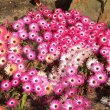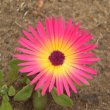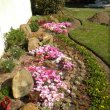| Botanical Name |
Dorotheanthus bellidiformis |
| Family |
Mesembryanthemaceae - The vygie family. |
| Pronunciation |
do-ro-thee-ANTH-us bel-id-ee-FORM-is |
| Common Name(s) |
|
| Plant Group |
- Succulent A plant having fleshy stems or leaves often adapted to dry conditions.
|
| Plant Size |
- Small
| Tree | 4m to 8m |
| Shrub | 50cm to 75cm |
| Perennial/ground cover | 10cm to 20cm |
| Bulb | 20cm to 30cm |
| Succulent | 10cm to 20cm |
|
| Position |
- Sun The area is in full sun for all or most of the day, all year round.
|
| General Information |
- Deciduous to Semi-deciduous In warmer areas a deciduous plant may not lose its leaves during winter at all, or may lose its leaves for a very brief period, or may only lose part of its foliage.
- Drought Tolerance: Moderate The plant is moderately adapted to arid conditions and can survive short periods of drought and high temperatures without extra water.
- Frost: Tender A plant that will not survive any frost or low winter temperatures.
- Sand tolerant Plants adapted to survive in nutrient poor, very sandy soils.
- Water Wise Plant species originating from low rainfall regions that require less water to survive and thrive than other plant species.
|
| Specific Information |
Dorotheanthus bellidiformis is a small succulent, annual vygie with reddish stems and fleshy, somewhat flaccid, greyish-green spoon-shaped leaves. The stems and leaves are covered with shiny, transparent dots, (known as papillae), which glisten like tiny balls of ice - hence the name 'ice-plant'. Although the plants are short-lived, they make an impressive sight in the cool days of spring, forming patches of brilliant colour with an almost iridescent sheen. The flowers close during dull, cloudy weather.
Despite being from a sub-desert area, the plant declines after spring and will not last through the heat of summer.
|
| Ad Break |
|
| Flowers |
| Description |
daisy-like vygie flowers up to 5 cm across with a satiny sheen
|
| Season |
- Spring to Summer Plants will seldom bloom for the entire season as given in the list, but should flower during a period within these parameters.
|
| Colour |
- yellow
- cream
- pink
- lavender
- magenta
- orange
|
| Growth Rate |
- Fast Specifying growth rate can be very misleading as there is considerable variation of growth rate depending on type and species of plant, available water, supplementary feeding, mulching and general care, as well as the plants suitability and adaptability to the garden environment.
|
| Plant Uses |
- Accent or Focal Point A plant used to attract the attention because of its colour or form.
- Attracts bees, butterflies or other insects This plant attracts insects which can be food for birds or other creatures in your garden.
- Bedding Plants, usually annuals, suitable for mass planting in beds for their quick colourful flowers or foliage and used to form a temporary display.
- Border A strip of ground, at the edge of a driveway or path in which ornamental plants or shrubs are planted.
- Container Trees, shrubs and ornamental species that can adapt to growing in a restricted environment.
- Edging A low growing plant that provides softness or definition to the edges of a bed or walkway.
- Filler Either a fast growing tree or shrub used temporarily to fill in an area while the permanent plants grow to a desired size, or a plant used to fill gaps in borders or beds.
- Ground Cover Low-lying plants that spread fast, require minimal maintenance, and cover large expanses or bare areas between bulbs or shrubs. They provide protection from erosion and drought and improve the visual appearance of the garden.
- Interplanting Arranging and planting plants in the garden that have different blooming times and habits of growth, extending the amount of time in which the area is in flower.
- Pioneer for new gardens A very fast growing plant, able to withstand hardship, that can be used to populate land that has recently been cleared of natural vegetation. These plants pave the way for slower-growing species by adding nutrients to the soil and creating leaf litter.
- Rock Garden An area constructed of larger rocks, arranged naturally, to emphasise the use of stones as a main element. Generally plants used do not need a lot of care.
- Suitable for coastal gardens Plants adapted to dry, sandy soil, forceful wind, limited rainfall and intense sunlight.
- Wild Garden An indigenous garden planted for the benefit of wildlife and birds. Provides food, water, a variety of mini-biomes and no poisonous chemicals are used.
|
| Distribution and Habitat |
from Namaqualand in the Northern Cape to Stilbaai in the Western Cape, on flat, sandy plains near the sea, and further inland in the Northern Cape
|
| Planting Suggestions |
Dorotheanthus bellidiformis is tolerant of most well drained soils and thrives in dry soil with low fertility. Propagate from seed sown in trays in early autumn, in a light and moist soil medium. Seeds germinate between one and three weeks after sowing. The young plants can be set into beds four to five weeks after germination. The seeds can also be sown directly into the garden but must not dry out completely.
To increase flower production, deadhead spent flowers every couple of days.
|
| Medicinal Uses |
|
| Ad Break |
|








Discuss this plant
Share knowledge, ask a question or give an experience.